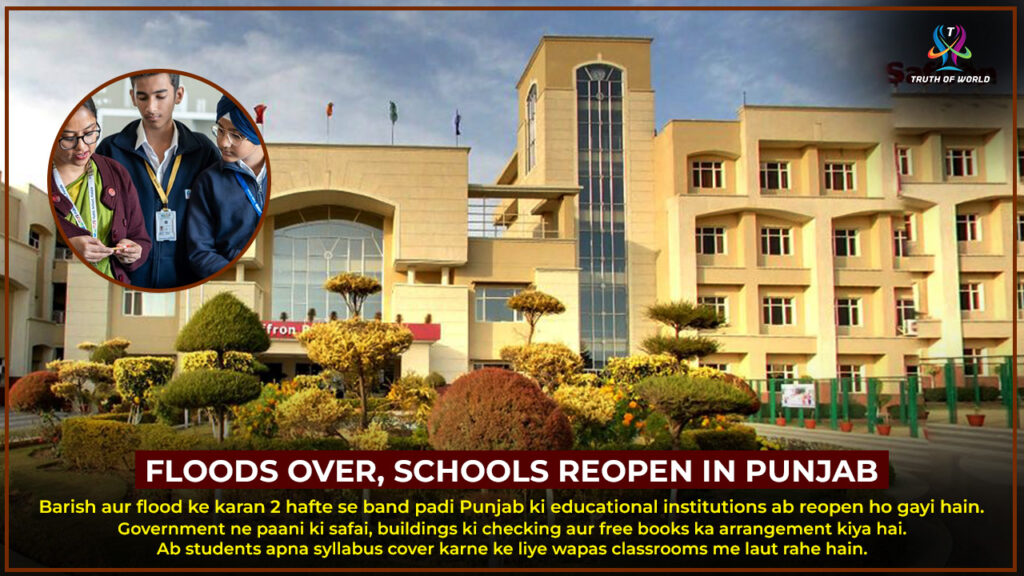Introduction
Punjab has witnessed one of the toughest times in recent years, with heavy floods disrupting not only daily life but also the education system across the state. Schools and colleges were forced to shut down for nearly two weeks as torrential rains and overflowing rivers created severe damage in many districts. On 9 September 2025, the Punjab government officially allowed schools, colleges, and universities to reopen, marking a hopeful turning point for students, teachers, and families who have been waiting for normalcy to return.
The reopening of educational institutions is more than just a step towards resuming classes. It is a sign of recovery, resilience, and rebuilding. The floods may have damaged infrastructure, but the spirit of the people of Punjab has remained unshaken. Let us take a detailed look into how this reopening impacts education, what measures have been taken for safety, and what challenges lie ahead.
Background: The Floods That Brought Punjab to a Standstill
During the last week of August 2025, Punjab experienced continuous rainfall that led to flooding in several districts, including Ludhiana, Patiala, Jalandhar, and Ropar. Rivers such as Sutlej, Beas, and Ravi overflowed, causing waterlogging in both urban and rural areas.
Educational institutions were among the most affected. Classrooms were submerged, furniture was destroyed, and roads connecting schools and colleges became inaccessible. The state government had no choice but to order an immediate closure of all schools and higher education institutions from 27 August onwards to ensure the safety of students.
This closure created a gap in learning, but it was a necessary step to protect young lives.
Impact of Floods on Education in Punjab
1. Academic Disruptions
Thousands of students across Punjab lost valuable study days. Schools that were preparing for mid-term examinations had to postpone schedules. Colleges and universities that had ongoing academic sessions faced difficulties in conducting lectures, lab work, and research activities.
2. Damage to Infrastructure
Many schools, especially in rural areas, reported damage to classrooms, playgrounds, and libraries. Walls collapsed, benches floated away, and in some cases, entire school grounds remained waterlogged for days.
3. Psychological Impact on Students
Natural disasters like floods leave not just physical damage but also emotional scars. Children and young adults living in flood-hit areas experienced stress, anxiety, and fear. For many, the thought of returning to school was mixed with relief and worry.
4. Digital Divide During Closures
Though some private schools attempted online classes during the closure, poor internet connectivity in rural Punjab created a digital gap. Not all students could afford or access online education, which widened the inequality in learning opportunities.

The Decision to Reopen on 9 September 2025
After monitoring the situation closely for nearly two weeks, the Punjab government finally announced that schools, colleges, and universities would reopen from 9 September onwards.
This decision was not taken lightly. Authorities consulted with district education officers, disaster management teams, and health departments to ensure that reopening would not put students at risk.
Education Minister of Punjab stated that “resuming education is as important as restoring roads and electricity. Our children’s future cannot remain on hold.”
Safety Protocols and Measures for Reopening
The government has issued clear guidelines to schools and colleges to ensure safety:
- Campus Inspections – Each institution was inspected by local authorities to ensure that classrooms and buildings are structurally safe.
- Clean Drinking Water – Schools have been instructed to check the quality of drinking water, as floods often contaminate sources.
- Health Camps – Free medical check-ups are being conducted in many schools to monitor students for waterborne diseases like cholera, dengue, and diarrhea.
- Psychological Counseling – Special sessions are being organized to help students deal with post-flood trauma and mental stress.
- Flexible Attendance – Recognizing that not all families can immediately send children back, schools are advised to adopt flexible attendance policies.
Voices from the Ground: Students and Parents
Students’ Reactions
For many students, reopening means reconnecting with friends, resuming learning, and moving forward after weeks of uncertainty. A student from Jalandhar expressed,
“I lost my books in the flood, but I am still excited to go back. Sitting in class again feels like life is back to normal.”
Parents’ Perspectives
Parents, while relieved, are also cautious. Safety remains their top concern. Some parents in flood-affected villages are demanding government support for free books, uniforms, and transportation since many families lost belongings in the disaster.
Teachers and School Management Challenges
While reopening is a positive step, teachers and administrators face the challenge of bridging the learning gap. Some institutions are considering extra classes or weekend sessions to cover the syllabus. Others are planning blended learning (offline + online) to make up for lost time.
Infrastructure repair is another hurdle. Schools that suffered heavy damage require financial support for rebuilding. Private schools may manage this quickly, but government schools in rural areas might take months.
Expert Opinions
Education experts believe that reopening is essential for children’s development. Dr. Anjali Mehta, a child psychologist, explains,
“The longer schools remain shut, the more it affects a child’s social and emotional well-being. Floods may have disrupted education, but timely reopening ensures students regain stability.”
Economists also stress that uninterrupted education is key to long-term growth. Delayed learning impacts not just individuals but the overall workforce of tomorrow.
Government Relief Measures for Education
The Punjab government has announced several relief steps:
- Free Books and Supplies: Distribution of study material to students who lost belongings in floods.
- Reconstruction Funds: Allocation of emergency funds to repair damaged school infrastructure.
- Scholarships: Special scholarships for children of farmers and laborers whose livelihood was hit by the floods.
- Digital Learning Support: Plans to provide tablets in rural areas to bridge the digital divide.

Long-Term Solutions to Protect Education from Natural Disasters
This flood crisis has highlighted the need for better preparedness. Experts recommend:
- Flood-Resistant School Buildings – Designing schools with elevated foundations.
- Disaster Management Training – Teaching students and teachers how to respond in emergencies.
- Hybrid Learning Models – Ensuring that education can continue online during closures.
- Emergency Funds – A dedicated budget for schools to recover quickly from natural disasters.
Community and NGO Support
Several NGOs have stepped in to support education recovery in Punjab. They are distributing books, uniforms, and even providing temporary learning spaces in community halls. Local communities are also volunteering to clean and repair schools, showing the resilience and unity of Punjab’s people.
The Spirit of Punjab: Moving Forward
Despite the destruction, Punjab’s reopening of schools and colleges is a symbol of resilience. It reflects the determination of the people to rebuild their lives and ensure that children’s education remains a priority.
Floods may have delayed learning, but the spirit of Punjab ensures that education will not stop. Students are returning with hope, teachers are preparing with dedication, and parents are standing strong to support their children’s future.
The reopening of Punjab’s schools and colleges on 9 September 2025 is not just about resuming classes. It is about restoring normalcy, healing communities, and building a stronger foundation for the future.
Education is the backbone of society, and even in the face of natural disasters, it must continue. Punjab’s step towards reopening shows that no matter how strong the floodwaters may be, the determination of its people to rise again is even stronger.
Author: Ronak Sharma
Main Ronak Sharma, ek content creator aur writer hoon jo education, technology aur social issues par likhta hoon. Mera aim hai readers ko authentic aur easy-to-read information provide karna. Punjab floods aur schools ke reopening ke baare me ye article maine likha hai taki aapko ground reality, government ke steps, aur students ke experience ke baare me clear samajh mile.




